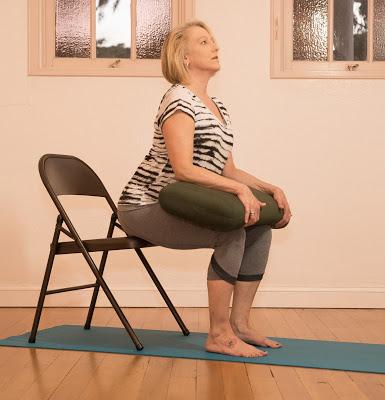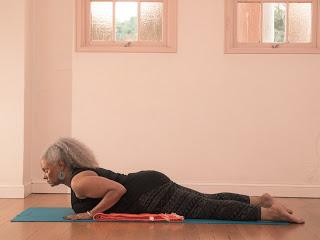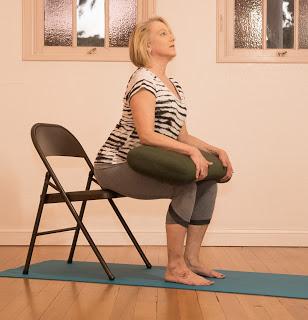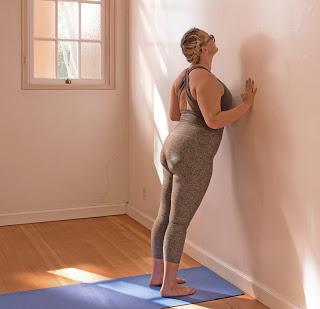
Photo by Sarit Z Rogers of Sarit Photography
Recently, Baxter invited me to look over his and Nina’s list of 36 essential poses that they chose for their upcoming book Yoga for Healthy Aging: A Guide to Lifelong Well-Being, pick one of my favorites from that list, and then share two or three variations of that pose that I recommend in addition to the ones they presentedIt’s a great list, and it was hard to choose just one! But I picked Cobra pose (Bhujangasana) because it feels like such an important pose for me and my students. There are so many things I love about Cobra. I would say that balancing out the kyphosis (rounding in the upper back) that comes from aging—and texting—might be the main one. I love backward bends because they are stimulating and energizing, and Cobra is also strengthening for the upper back, arms and chest.
One subtle benefit that I focus on with my students is the relationship of Cobra and the breath. In this pose, we get to experience the pressure of the abdomen against the floor with each inhalation. This sensation is helpful in connecting with the breath while holding a pose. It creates a feeling of continuous movement in what looks like a static position, and it increases awareness of the subtle movements that happen while you’re in a pose.
Here are my favorite three versions. (See Featured Pose: Cobra Pose for Baxter and Nina’s versions of the pose, including the classic version.)
Version 1: Low Cobra with a Blanket

Photo by Sarit Z Rogers of Sarit Photography
This is a gentle way of practicing a traditional Cobra pose on the floor. It is particularly useful for people who have lower back pain due to bulging or herniated discs, as well as those who have a kyphosis or the beginning of one.A blanket is used underneath the abdomen to lift the top of the pelvis and lengthen the lower back. In effect the blanket helps to reduce lordosis (the lumbar curve) and helps avoid pinching in the low back. The blanket can also create space for a larger belly or breasts, which otherwise may feel smashed in the pose.
People who have a deep kyphosis can practice the pose with their head in line with their neck and avoid looking up and back. This can reduce pinching in the back of the neck, which can occur from the neck overcompensating for a lack of flexibility in the upper back. Also, some people with lower back pain find that widening the legs apart from each other can reduce tension in that area.As I mentioned above, this is a great opportunity to connect with your breath and the movement of your diaphragm, which we experience through the abdomen pressing against the floor. I always begin by exhaling while grounding the pelvis into the floor followed by inhaling while lengthening the spine and slowly allowing the head to float up. Another useful pointer is to stay low, only lifting to the point where you feel your upper back engaged. When you come up to a full Cobra, the work moves down to your lower back, and is a very different experience. Also, try coming up without putting any pressure into your hands to see if you can focus on the upper back strengthening aspect. Or, pull your hands along the mat towards your abdomen to emphasize lengthening the spine and expanding the heart.Version 2: Seated Cobra with Bolster

Photo by Sarit Z Rogers of Sarit Photography
Cobra pose is a great practice for chair yoga because you can still get many of the benefits for the upper back and spine. Unfortunately, what’s lost in this pose, and many other chair poses is the abdominal massage that you get when practicing on the mat. And people who sit a lot because of a disability or age may have stagnant digestion and constipation. So this benefit is something we need to bring back into the chair version of Cobra.In order to get that abdominal massage, try sitting with a bolster on your lap, perpendicular to your legs. Gently hug the bolster in towards your abdomen and hold it there during the practice. To come into the pose, hinge forward at your hips and lower your head towards floor. Then come up slowly raising your head, neck and chest. Feel that your chest is moving forward and lengthen your spine as you look up gently.
Version 3: Standing Cobra
Photo by Sarit Z Rogers of Sarit Photography
This standing variation of Cobra pose offers a little variety for people who are unable to practice the traditional form prone on the floor. Begin in Mountain pose (Tadasana) with your hands on the wall at shoulder height. The challenge here is to find the correct distance to stand from the wall. This depends on body proportions, so it’s best to try out a few different distances yourself.Here the body’s relationship to gravity has shifted, so it’s important that you don’t drop your head back. Rather, keep lengthening your spine and look up gently. Also, some people like to bring your chest and/or chin to the wall. Just remember to bring the awareness to your upper back, lifting your chest and lengthening your spine. And of course, focus on steadying the mind!
My favorite use of this variation is in a Wall Sun Salutation. But we’ll have to save that for another day.
If you want to see me in person (along with many other knowledgeable teachers) and learn more about Accessible Yoga, our next conference takes place in San Francisco, CA, October 6-8, 2017. Register here!

For over twenty-five years Jivana has specialized in teaching yoga to people with disabilities with an emphasis on sharing yoga philosophy. His passion is making yoga accessible to everyone. Jivana has led more than fifty yoga teacher training programs around the world. In December 2015, Jivana was invited to teach Accessible Yoga at the United Nations in Geneva, and he continues to work toward expanding access to the teachings of yoga. For more information and upcoming Conferences and Trainings visit www.accessibleyoga.org
Subscribe to Yoga for Healthy Aging by Email ° Follow Yoga for Healthy Aging on Facebook ° Join this site with Google Friend Connect

